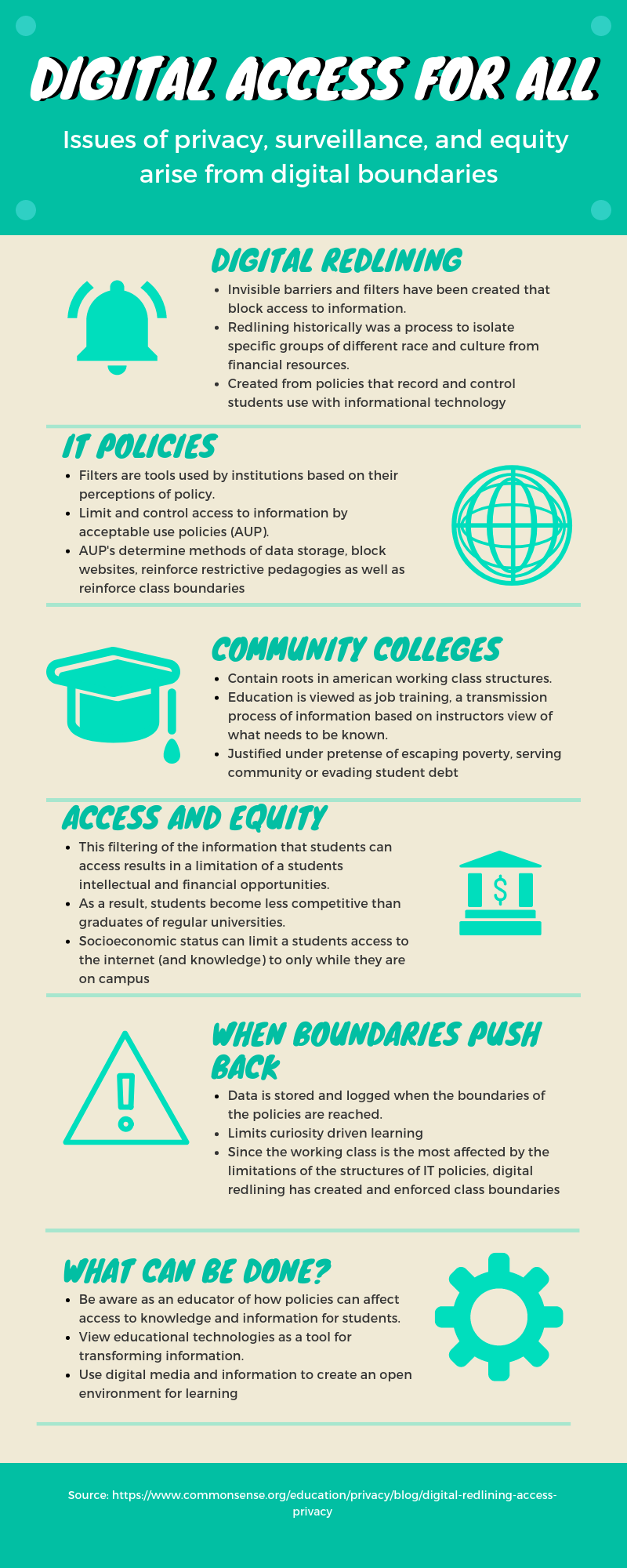I decided to respond to the article Digital Redlining, Access, and Privacy by Chris Gilliard by creating an infographic using Canva. The article talks about the invisible boundaries imposed on community college students due to the informational technology policies put in place by these institutions. These policies and algorithms act like filters which limit the type and amount of information the students have access to, which impacts the future financial opportunities of the students. This places the students at a disadvantage when compared to graduates of higher-level institutions, who generally do not experience these filters. A core component argued by Gilliard in this article deals with the working-class roots of community colleges, and how digital barriers are being transformed to reinforce class, race and ethnic boundaries. The article ends on an uplifting note that I agree with, a call for educators to be aware of the limits imposed on students by educational technologies. We must be careful not to categorize our students like the IT policies do and strive for creating an open environment for learning and this can be done by carefully choosing the programs and activities we assign to our students. We need to make sure these barriers are not something that we make students encounter.
Ill admit that I never really thought about how the policies in place at some institutions could have a more profound impact than simply not having access to that information. I ignored the fact that if some students can’t access the information at campus, they can’t access it at all and the information does not exist for them. My personal experience and upbringing has always allowed me the freedom and opportunity to pursue and use informational technology both at home and at school. During public school, when I was blocked from playing games or visiting YouTube on the school computers, it made sense to me because that really wasn’t what I was supposed to be doing. Now that I know about digital redlining, I have to consider the angle that I was being limited in my education because something like YouTube has profound educational use.
The most shocking thing about reading this article was the revelation that for some students without access to internet at home, their future job potential and equity is adversely affected. I used to think that these IT policies put in place by some campuses were necessary to protect the users from harm from malicious websites or prevent access to websites that were inappropriate to a school environment. While this is certainly true, it is hard to look at some of these restrictions in the same way knowing that it has severe repercussions for some students attending a different campus. I now know that, intentional or not, the filters utilized by IT polices at community colleges reinforce the boundaries of race and class present in the real world. With this new information, it is important that I approach the discussion and use of digital redlining with the gravity it deserves and try to use digital media to transform educational experiences for students, not diminish them.
My experience with Canva was not a smooth one, I became extremely frustrated by the limitations of the program. I’m reminded of the Ashely Hinck article, Digital Ghosts in the Modern Classroom, describing the limitations of template programs and could not agree more here. The free version of Canva has very little elements, images and icons available to use, with premium features available for one dollar. This creatively limited what I could present and achieve, which made me feel that an infographic may not have been the best way to respond and reflect on the article. The free and premium features encountered could be viewed as a boundary or limitation. Those without the means to afford a premium account are limited to the responses they can create, and the quality of their infographic is lessened. I found Piktochart, the program I used last for the prior reflection to have more powerful editing options and gave more freedom with a free account.
Brandon Varga

